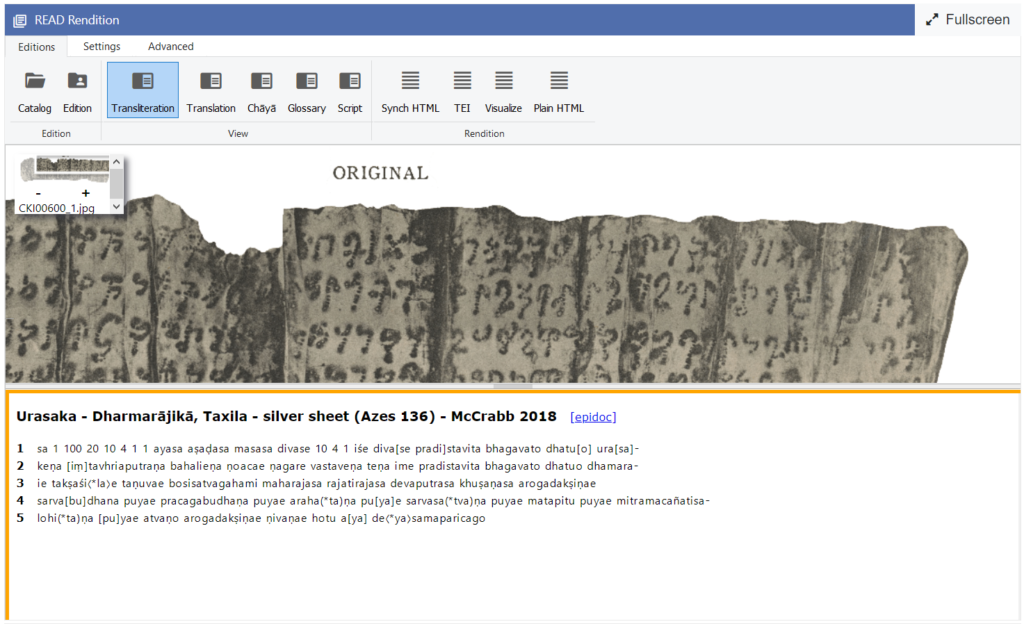The Budhanada – schist Buddha Triad is one of only five inscribed Buddha images from Gandhara. The inscription is dated to year five of presumably the Kaniṣka era that commenced in 127 CE and is most likely from the second century of this dating system. The text states that this was a donation made by Budhanada, who is identified as one versed in the Tripiṭakas suggesting that he was a monk, and he directed the merit of this gift to his deceased parents. The image is a schist stele depicting the Buddha seated on a lotus throne and flanked by two Bodhisattvas, Maitreya on the Buddha’s right and Avalokiteshvara to his left. These three figures complete the triad. Positioned above Buddha’s shoulders are two Indic gods, Brahma to the Buddha’s right and Indra on the left. The provenance of this image is unknown but based on objects with similar stylistic features it was likely from the Charsadda, Takht-i-Bāhi, Sahrī-Bahlol region located northeast of Peshawar, Pakistan.
Conventional Name Year 5 Buddha | Item Schist sculpture | Findspot Unknown | Surface Recto | Dimensions Height: 61.6cm, Width: 59.1cm | Date Year 5 | Collection Private | Current Location Metropolitan Museum of Art, New York, United States | Language/Script Gāndhārī/Kharoṣṭḥī
Content Summary
Budhanada, a monk who knows the Tripiṭaka, makes a donation (pious gift) in year 5 and honors his deceased parents.
Keywords
Donation, EraRulerDate, Honor
Previous Editions
-
Fussman, Gérard. 1974. “Documents épigraphiques kouchans.” Bulletin de l’École française d’Extrême‐Orient 61: 1–66.
-
Harle, J. C. 1974. “A Hitherto Unknown Dated Sculpture from Gandhāra: A Preliminary Report.” In: J. E. van Lohuizen‐de Leeuw and J. M. M. Ubaghs, eds., South Asian Archaeology 1973: Papers from the Second International Conference of the Association for the Promotion of South Asian Archaeology in Western Europe Held in the University of Amsterdam, pp. 128–35. Leiden: E. J. Brill.
Other References
-
Bibliographic details of references to this inscription, and a revised reading of Fussman’s edition by Stefan Baums, are available from Gāndhārī Language and Literature
-
Acknowledgements
Development of the 3D model was facilitated by John Guy (The Met, New York). Research on this inscription and production of the digital edition was completed with the generous support of Prakaś Foundation and the Power Institute (University of Sydney).
Digital publishing by Ian McCrabb
Each digital edition includes background information about the text, a summary of its content, and references to parallel texts and related publications. Users can explore the text, image, and other analysis resources through various preset views from the READ interface, or customize the views themselves.
By developing the text in READ, the text and image are linked such that selecting a syllable, word, or compound in the text or glossary will highlight the associated akṣaras on the manuscript. This allows you to in effect “read” the manuscript as you read the transcribed text, even if you do not know the script.
Users can choose from several preset READ views by selecting the tabs at the top. Each of these convenient arrangements of text and resources is suited to a different experience with the manuscript. For instance, choose the Script view to study the paleography of the manuscript or the Glossary view to study its vocabulary. It is recommended that the user toggles through the default views to gain a holistic perspective of the text.

- Transliteration: Image and transliteration.
- Translation: Transliteration and translation.
- Chāyā: Transliteration and chāyā.
- Glossary: Image, transliteration, and glossary.
- Script: Image, transliteration, and script chart
- Visualize: Visualize the text structure display.
- Synch HTML: Interactive synchronized rendition.
- TEI: EpiDoc TEI rendition.
- Plain HTML: Transliteration in HTML format.
Avś
Be
Ce
Ch.
CPS
DhG
Ee
FJJ
Mahīś
MūSā
Mvu
P
SĀ
SBhV
Se
Skt.
SN
T
Tib.
Vin
Avadānaśataka (ed. Speyer 1906–1909)
Burmese (Chaṭṭhasaṅgāyana) edition
Sri Lankan (Buddha Jayanti Tipiṭaka Series) edition
Chinese
Catuṣpariṣat-sūtra (ed. Waldschmidt 1952–1962)
Dharmaguptaka
European (Pali Text Society) edition
Fobenxing ji jing (T 190)
Mahīśāsaka
Mūlasarvāstivāda
Mahāvastu-avadāna (ed. Senart 1882–1897)
Pali
Saṃyukta-āgama (T 99)
Saṅghabhedavastu (ed. Gnoli 1977–1978)
Thai (King of Siam) edition
Sanskrit
Saṃyutta-nikāya
Taishō 大正 edition
Tibetan
Vinaya

